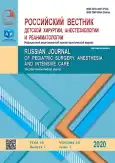Кистозная форма билиарной атрезии. Опыт лечения
- Авторы: Борисова И.И.1,2, Каган А.В.1,2, Караваева С.А.2,3, Котин А.Н.1,2
-
Учреждения:
- Федеральное государственное бюджетное образовательное учреждение высшего образования «Первый Санкт-Петербургский государственный медицинский университет имени академика И.П. Павлова» Министерства здравоохранения Российской Федерации
- Санкт-Петербургское городское бюджетное учреждение здравоохранения «Детский городской многопрофильный клинический специализированный центр высоких медицинских технологий»
- Федеральное государственное бюджетное образовательное учреждение высшего образования «Северо-Западный государственный медицинский университет имени И.И. Мечникова» Министерства здравоохранения Российской Федерации
- Выпуск: Том 10, № 1 (2020)
- Страницы: 17-24
- Раздел: Оригинальные исследования
- URL: https://journals.rcsi.science/2219-4061/article/view/123433
- DOI: https://doi.org/10.17816/psaic603
- ID: 123433
Цитировать
Полный текст
Аннотация
Обоснование. Кистозная форма билиарной атрезии — редкая форма атрезии желчевыводящих путей, которая является относительно благоприятным вариантом порока и может быть диагностирована антенатально. На практике важно не только заподозрить этот диагноз, но и дифференцировать этот вариант нарушения развития наружных желчных протоков от кисты общего желчного протока. Это связано с различием в подходах и методах хирургического лечения кист холедоха и билиарной атрезии. Облитерация (атрезия) желчных протоков при отсутствии своевременного хирургического вмешательства быстро приводит к прогрессированию цирроза печени и развитию печеночной недостаточности. Методом выбора в лечении билиарной атрезии является операция Kasai, часто носящая паллиативный характер, но позволяющая отсрочить время до трансплантации печени. Киста общего желчного протока редко требует раннего хирургического лечения, а риск формирования цирроза печени значительно ниже. Хирургическое вмешательство направлено на удаление кисты и восстановление тока желчи путем анастомозирования наружных желчных протоков с кишечником, что является радикальным способом лечения и приводит к выздоровлению ребенка. Внешняя схожесть при ультразвуковом исследовании плода и новорожденного ребенка кистозной формы билиарной атрезии желчных ходов с кистой общего желчного протока не всегда позволяет дифференцировать один порок от другого, что может привести к несвоевременной коррекции порока и неблагоприятному исходу.
Цель. Продемонстрировать редкий тип билиарной атрезии.
Материал и методы. За период с 2001 по 2019 г. в Детском городском многопрофильном клиническом специализированном центре высоких медицинских технологий города Санкт-Петербурга на лечении находилось 33 пациента с билиарной атрезией, кистозная форма выявлена только у двух больных. Оба ребенка первоначально трактовались как пациенты с кистой холедоха. Дети были оперированы в возрасте 2 и 3,5 месяцев. Первому пациенту выполнена операция Kasai, второму — наложен гепатикоеюноанастомоз.
Результаты. За время наблюдения (9 лет и 4 года) синтетическая функция печени в норме, показаний к трансплантации в настоящее время нет.
Заключение. При обнаружении у плода или новорожденного с неонатальной желтухой при ультразвуковом исследовании кистозного образования в воротах печени очень важно правильно и быстро провести дифференциальный диагноз между кистозной формой билиарной атрезии желчных путей и кистой холедоха.
Ключевые слова
Полный текст
Открыть статью на сайте журналаОб авторах
Ирина Ивановна Борисова
Федеральное государственное бюджетное образовательное учреждение высшего образования «Первый Санкт-Петербургский государственный медицинский университет имени академика И.П. Павлова» Министерства здравоохранения Российской Федерации; Санкт-Петербургское городское бюджетное учреждение здравоохранения «Детский городской многопрофильный клинический специализированный центр высоких медицинских технологий»
Автор, ответственный за переписку.
Email: Zarvi@bk.ru
аспирант кафедры детской хирургии с курсом анестезиологии и реанимации; врач-детский хирург
Россия, Санкт-ПетербургАнатолий Владимирович Каган
Федеральное государственное бюджетное образовательное учреждение высшего образования «Первый Санкт-Петербургский государственный медицинский университет имени академика И.П. Павлова» Министерства здравоохранения Российской Федерации; Санкт-Петербургское городское бюджетное учреждение здравоохранения «Детский городской многопрофильный клинический специализированный центр высоких медицинских технологий»
Email: db1@zdrav.spb.ru
д-р мед. наук, профессор, заведующий кафедрой детской хирургии с курсом анестезиологии и реанимации; главный врач
Россия, Санкт-ПетербургСветлана Александровна Караваева
Санкт-Петербургское городское бюджетное учреждение здравоохранения «Детский городской многопрофильный клинический специализированный центр высоких медицинских технологий»; Федеральное государственное бюджетное образовательное учреждение высшего образования «Северо-Западный государственный медицинский университет имени И.И. Мечникова» Министерства здравоохранения Российской Федерации
Email: svetlana.karavaeva@szgmu.ru
д-р мед. наук, профессор, заведующий кафедрой детской хирургии; врач-детский хирург
Россия, Санкт-ПетербургАлексей Николаевич Котин
Федеральное государственное бюджетное образовательное учреждение высшего образования «Первый Санкт-Петербургский государственный медицинский университет имени академика И.П. Павлова» Министерства здравоохранения Российской Федерации; Санкт-Петербургское городское бюджетное учреждение здравоохранения «Детский городской многопрофильный клинический специализированный центр высоких медицинских технологий»
Email: alexey.kotin@mail.ru
канд. мед. наук, доцент кафедры детской хирургии с курсом анестезиологии и реанимации; врач-детский хирург
Россия, Санкт-ПетербургСписок литературы
- Balistreri WF, Grand R, Hoofnagle JH, et al. Biliary atresia: current concepts and research directions. Summary of a symposium. Hepatology. 1996;23(6):1682-1692. https://doi.org/10.1002/hep.510230652.
- Govindarajan K.K. Biliary atresia: where do we stand now? World J Hepatol. 2016;8(36):1593-1601. https://doi.org/10.4254/wjh.v8.i36.1593.
- Lobeck IN, Sheridan R, Lovell M, et al. Cystic biliary atresia and choledochal cysts are distinct histopathologic entities. Am J Surg Pathol. 2017;41:354-364. https://doi.org/10.1097/PAS.0000000000000805.
- Sokol RJ, Shepherd RW, Superina R, et al. Screening and outcomes in biliary atresia: Summary of a National Institutes of Health workshop. Hepatology. 2007;46:566-581. https://doi.org/10.1002/hep.21790.
- Redkar R, Davenport M, Howard ER. Antenatal diagnosis of congenital anomalies of the biliary tract. J Pediatr Surg. 1998;33(5):700-704. https://doi.org/10.1016/s0022-3468(98)90190-7.
- Kim WS, Kim IO, Yeon KM, et al. Choledochal cyst with or without biliary atresia in neonates and young infants: US differentiation. Radiology. 1998;209(2):465-469. https://doi.org/10.1148/radiology.209.2.9807575.
- Mackenzie TC, Howell LJ, Flake AW, Adzick NS. The management of prenatally diagnosed choledochal cysts. J Pediatr Surg. 2001;36(8):1241-1243. https://doi.org/10.1053/jpsu.2001.25784.
- Suita S, Shono K, Kinugasa Y, et al. Influence of age on the presentation and outcome of choledochal cyst. J Pediatr Surg. 1999;34(12):1765-1768. https://doi.org/10.1016/s0022-3468(99)90308-1.
- Schooler GR, Mavis A. Cystic biliary atresia: A distinct clinical entity that may mimic choledochal cyst. Radiol Case Rep. 2018;13(2):415-418. https://doi.org/10.1016/j.radcr.2018.01.025.
- Caponcelli E, Knisely AS, Davenport M. Cystic biliary atresia: an etiologic and prognostic subgroup. J Pediatr Surg. 2008;43(9):1619-1624. https://doi.org/10.1016/j.jpedsurg.2007.12.058.
- Zhou LY, Guan BY, Li L, et al. Objective differential characteristics of cystic biliary atresia and choledochal cysts in neonates and young infants. JUM. 2012;31(6):833-841. https://doi.org/10.7863/jum.2012.31.6.833
- Hill SJ, Clifton MS, Derderian SC, et al. Cystic biliary atresia: a wolf in sheep’s clothing. Am Surg. 2013;79(9):870-872.
- Hsiao CH, Chang MH, Chen HL, et al. Universal screening for biliary atresia using an infant stool color card in Taiwan. Hepatology. 2008;47(4):1233-1240. https://doi.org/10.1002/hep.22182.
- Tang J, Zhang D, Liu W, et al. Differentiation between cystic biliary atresia and choledochal cyst: A retrospective analysis. J Paediatr Child Health. 2018;54(4):383-389. https://doi.org/10.1111/jpc.13779
Дополнительные файлы











